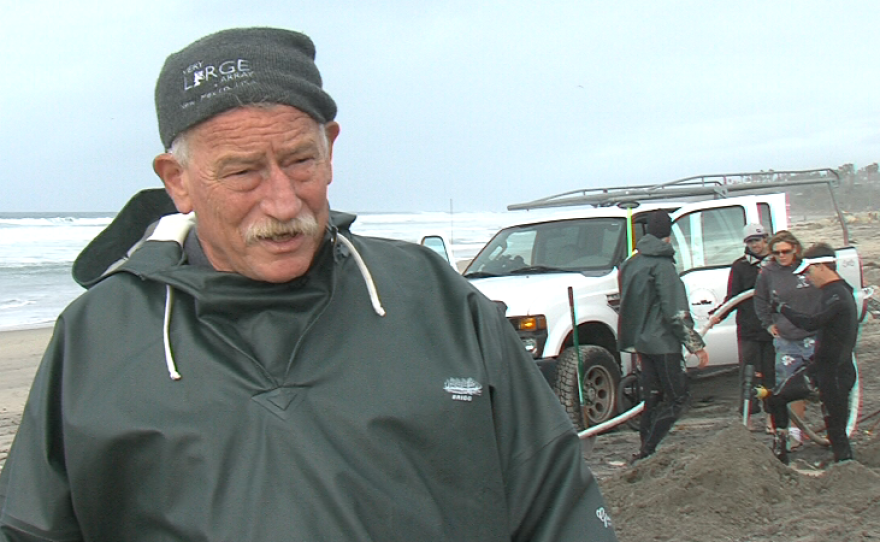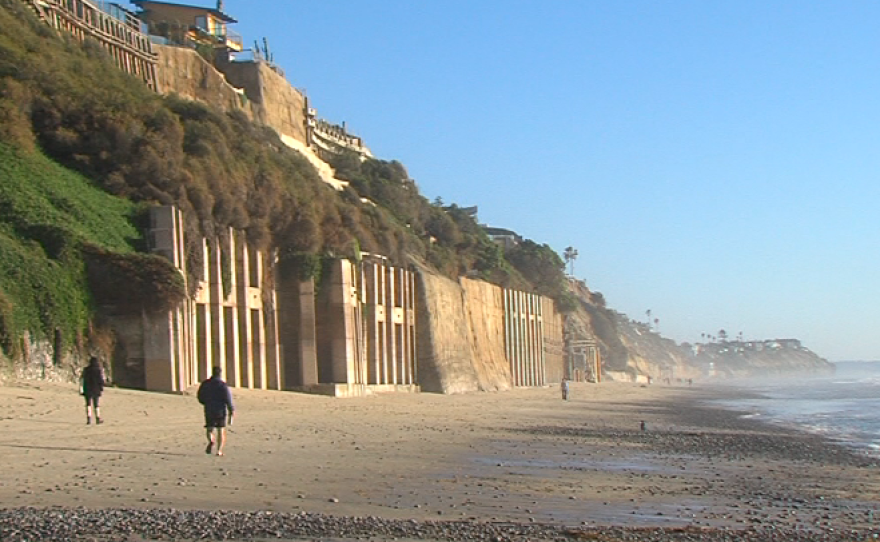Sea cliffs have crumbled and several beaches in North County have eroded down to pebbles by high tides and El Niño storms. This winter may reveal how expensive it would be to preserve San Diego beaches as sea levels rise.
Encinitas Lifeguard Capt. Larry Giles keeps a close eye on the cliffs at Beacon's Beach in Leucadia. During the last storms, several large boulders broke away and rolled down onto the beach.
Not far away, Giles spots beachgoers who are sitting tucked into an overhang in the cliffs to get out of the wind. He gives them a warning.
"Hey, just to let you know, we’ve been having a lot of cliff collapses," he told them. "You’re in such a place where — if something were to happen — there’s probably no tomorrow for you."
Cliff erosion is part of the natural cycle that replenishes beach sand. But huge sea walls erected by property owners to protect their bluff-top homes are partly why beach sand that gets washed away in winter storms is not being replaced.
Parts of the beach near Beacon's are now just piles of pebbles.
"What happened to the beach?" asks a passing beach walker. Giles explained winter storms always wash away sand, and this year’s El Niño storms may be making it worse.
"A lot of the sediment doesn’t make it to the beach any more," Giles said. "There’s a lot of growth and development in North County, so that sediment isn’t getting to the coastline any more."

In Oceanside, much of the beach is completely down to cobblestones. And some of the rocky rip rap piled up to protect The Strand has been washed away.
During recent king tides the waves broke over the road, scattering pebbles into the driveways of beachfront cottages and flooding a construction site where new condos are being built.
Sea level rise
Robert Guza, professor of oceanography at Scripps Institution of Oceanography, said places that flood intermittently now could find themselves flooded on a daily basis in the long term. He said this winter’s king tides and El Niño storms will give us a glimpse into the future of sea level rise.

"The reason I say that is because sea level is higher during El Niño — because of the wind patterns and because the water is warmer — so the water level is higher, maybe 15 or 20 centimeters," Guza said. "That may be, depending on sea level rise, the equivalent of 30 or 40 or 50 years of sea level rise."
Guza and his team are burying sensors in local beaches, including Cardiff, to collect data on sand erosion. His focus is on areas where millions of dollars have been spent on sand replenishment projects.
Sand replenishment
The cities of Encinitas and Solana Beach both received thousands of cubic yards of extra sand when a San Diego Association of Governments, or SANDAG, program added 1.5 million cubic yards of sand to beaches in eight cities in 2012. That program cost $28.5 million.
"Clearly, the question of 'how long does it last?' is very relevant," Guza said. "Is it worth doing?”
One of Guza’s colleagues, Timu Gallien, has given Encinitas a wheeled device that measures sand levels to within a couple of centimeters using GPS. The city is collecting data after every storm on how the beach sand is moving.
But, Guza said, the scientific models for measuring sand erosion are still imprecise, so it is not possible to reach firm conclusions.

Solana Beach has perhaps the most vulnerable cliffs in Southern California, with almost two miles of sandstone bluffs, 70 to 80 feet high. At high tide, the waves pound the base of those cliffs. Armoring them with sea walls has deprived the beach of a new source of sand to replace sand washed out to sea.
Those property owners already pay a sand replenishment fee, and the city is proposing to start charging them a second fee of $870 per linear foot to mitigate for lost recreational opportunities along the beach.
Lifeguard Capt. Craig Miller said the beach can lose eight to 10 feet of sand in winter. Anecdotally, he said, SANDAG’s 2012 sand replenishment program has made a big difference.
"A lot of us were skeptical because there’s no sand retention device," Miller said. "And one good storm like this could have taken a lot of that sand away. But it ended up sticking around. There’s very little of it left but there’s still a little bit left."
But SANDAG is not proposing any more sand replenishment projects that cost millions of dollars. The agency is still collecting data on the effectiveness of the 2012 project and the results are inconclusive.
The executive summary of the 2014 report concludes:
"When the three-year RBSP II Monitoring Period is considered, the shoreline position advanced at two receiver beaches, decreased at two, and remained essentially unchanged at the remaining four sites."
Rob Rundle, principal regional planner for SANDAG, said a working group of coastal cities makes recommendations to the board.
"If we had evidence that it was completely not worth it, then that would be a big issue that policy makers would have to address and say, 'why are we doing this?'" Rundle said. "But we don’t have that yet. We’ve shown that there is a benefit to putting sand on the beach. The tricky question is, is it enough of a benefit, does it last long enough? If we did nothing, what we be the consequences? We don’t know the answer to that."
The Army Corps of Engineers last year approved a 50-year sand replenishment program for Encinitas and Solana Beach, beginning in 2017. But that would cost $135 million, and the money has not yet been found.
Opportunistic sand replenishment

In the meantime, beach cities are looking for what they call "opportunistic sand" anywhere they can. Kathy Weldon, shoreline manager for Encinitas, said the city is on the lookout for appropriate material.
"We’re looking for sand from onshore resource projects, whether it’s a parking structure that has good Torrey sandstone that they’ll be digging out — to get rid of it, we’ll have a site at Moonlight and Beacon's and Ponto to dispose of that material."
Weldon said the city has successfully used these opportunistic sand sources in the past. But, she said, this El Niño season "could be a game changer" for her city’s beaches.
The city of Oceanside has just obtained a five-year "opportunistic sand replenishment" permit from the California Coastal Commission, allowing the city to use sand from inland sources. City engineer Scott Smith said he hopes the material dredged from the foundations of a new pier-side hotel might be suitable.
Beaches uncertain future
Sea level along Southern California shores could rise by as much as a foot in the next 15 years and up to two feet by 2050, according to the state’s best estimate.
California Coastal Commission spokeswoman Noaki Schwartz said her agency received $3 million in Gov. Jerry Brown’s latest budget to retain 25 staff who will focus full-time on the implications of sea level rise for coastal communities.
Guza said a major investment is needed to protect those beaches.
"Build a highway, you have to maintain it — it falls apart if you don’t maintain," Guza said. "We’re in a situation with beaches, if you don’t maintain it, they’re going to go away."






